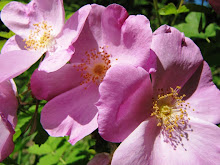The baby cottontail rabbit above is colored like the dirt and brush around it. The tiny lines of dark fur mixed in with its dirt-colored fur make it blend into its environment. Because it holds so still, it is easy to walk right past it without ever seeing it!

The grey squirrel in the above picture stretches out on a grey branch of a maple tree. Can you see him and his bushy tail?
The female woodcock above has her back to you because she is trying to lead you away from her babies. She is easy to see on the gravel road, but when she gets into the woods she seems to disappear. Her feathers are so mottled [4] that she looks like part of the forest floor. You will only see her after you almost step on her and she flies away and leaves you with your mouth open.

Because baby animals are especially vulnerable[5] to predation, God often gives them a cammoflage that makes them look different than their parents. The baby robin above is all speckled, making it hard to see when it holds still and is quiet.

This western ground squirrel, like it's cousin the Franklin's ground squirrel which it resembles, has speckled fur so that it can blend into rocks, grass, or bare dirt.
Above is a picture of an American Toad in the little mud house it found in a vegetable garden. The toad blends into the dirt so well that I placed an arrow pointing to it. If you look closely you can see the toad's eye and then the rest of its body.

There are few critters more cute than a new-born fawn. Fawns have speckles on them for many months, helping them hide in the woods and grass they live in. This little fawn was so well hidden that I had to look for a long time to find it, even though I saw where it had laid down in the grass!
Don't worry, the critter above is not a snake! It is a Northern Prairie Skink, which is a small lizard. The stripes on its body make it disappear in grass, but should it get caught by the tail it has another trick given to it by God: its tail will come right off as the skink hurries away! The skink will then grow another tail and be as good as new.

Baby birds are not the only ones to have some cammoflage. The Song Sparrow pictured above has stripes to help it hide. See how well it blends into the apple tree it is sitting on?

Lastly, we have those critters that can actually change color to blend into
their environment. This tree frog sitting on top of a sunflower has changed to green so that the bugs can't see him as he hunts them. If he hops over to a tree and climbs that (yes, treefrogs can climb!) he will change to a mottled grey color to hide on the bark of the tree.
These are just a few of the many kinds of critters with a God-given cammoflage. Keep your eyes open as you go out to enjoy nature; watch for any little movement that may help you see a hidden animal; and be prepared for surprises when an animal you haven't seen takes off from right beside you and runs away!




No comments:
Post a Comment